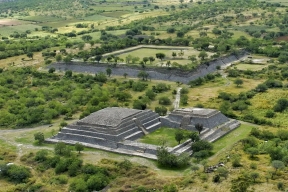Guanajuato archaeological sites will be open at the end of the year
News Category: News, Community News, and General Discussion
-
The map of destinations to visit this year must undoubtedly include the five archaeological sites in the state of Guanajuato, which in 2021 expanded their attractions with the opening of Complex B at the Arroyo Seco rock painting site in the municipality of Victoria.
In addition to this ancestral legacy in the northeast of the state; Guanajuato has four enclaves of architectural vestiges: Plazuelas, in Pénjamo; Peralta, in Abasolo; El Cóporo, in Ocampo and the archaeological zone Cañada de la Virgen, highlighted in 2019 as a Cultural Heritage Treasure of San Miguel de Allende.
Plazuelas was the first archaeological zone opened to the public in Guanajuato, 15 years ago. It was one of the most complex pre-Hispanic cities in the southern region of the state, standing out for its harmonious integration into the landscape of the Sierra de Pénjamo. Its occupation occurred between 600 and 900 AD.
The buildings of this site were built in a dispersed way, communicating with each other through long roads and paths that go up and down between the slopes of a couple of ravines. Its main elements are a court for the ball game and a set of squares and pyramidal bases that have been named Casas Tapadas of great beauty and architectural richness. Admirable is also the abundance of petroglyphs scattered among the rocks of the place.
About 70 kilometers from Plazuelas, in the municipality of Abasolo, is Peralta, a site whose monumental construction places it among the largest civic ceremonial centers of this portion of Mesoamerica. It was inhabited between 300 and 750 AD.
Peralta is conformed by diverse architectural groups distributed into six great groups. Among the monuments of this settlement deserve special attention the ceremonial building called Double Temple and Sunken Patio as well as the Enclosure of the Rulers, the largest architectural element of Peralta and one of the largest platforms associated with the El Bajío tradition, with more than 130 meters per side and 12 meters high.
The Cañada de la Virgen archaeological zone, in San Miguel de Allende, is currently the most visited archaeological site in the state. It is an ancient ceremonial center whose urban layout reflects the cosmic cycles to which the life of the surrounding communities was linked, with an axis of symmetry directed towards the rising and setting of the sun.
The heart of this site is located on the top of a hill associated with a set of deep ravines and its peak took place between 640 and 900 AD. The settlement is conformed by several architectural complexes closely linked among which stands out the House of the Thirteen Heavens, a pyramidal base of 15 meters high, with lateral platforms that close a wide sunken patio.
Already in the border strip of Mesoamerica is El Cóporo, an important pre-Hispanic settlement, inhabited between 500 and 900 AD. In its urban design, there is a clear differentiation of spaces: with public and domestic areas in its lower part and civic and ceremonial complexes located on the slopes and the top of the hill that gives its name to the site.
Finally, Arroyo Seco is one of the most important rock art concentrations in the country. It has more than 42 pictorial panels distributed among rock shelters scattered on two hills, known as La Zorra (Complex A) and La Tortuga (Complex B). These paintings were painted over the course of several centuries and range from the passage of hunters and gatherers to the first years of the conquest.
In both elevations, geometric and anthropomorphic motifs are in the majority, although a few representations that are not found in Complex B, such as hunting scenes and phytomorphic motifs, like those of the peyote, stand out.
The archaeological zones of Guanajuato will be closed only on December 25 and January 1. On the other days, they will maintain their usual hours of operation: Tuesday to Sunday, from 10:00 to 18:00 hours (with last access to visitors at 17:00 or 16:00 hours, depending on the site). General admission is 39 pesos and 12 pesos for children under 12 years old. For your visit, the sanitary protocol Cultura en Guardia is applied, which includes the mandatory use of masks and entrance through a sanitary filter.
-


Leave a Reply